Dynamic Behaviours of a Filament in a Viscoelastic Uniform Flow
Abstract
:1. Introduction
2. Mathematical Model and Numerical Method
3. Validation
3.1. A 2D Filament Flapping in a Newtonian Uniform Flow
3.2. Grid Convergence Study of the Filament Flapping Motion in a Viscoelastic Uniform Flow
3.3. Determination of the Prandlt Number
4. Results and Discussion
4.1. The Filament Behaviours in a Giesekus Uniform Flow
4.1.1. The Effects of Wi and Re on the Flapping Motion of the Filament
4.1.2. The Effects of Wi and Re on the Drag and Lift Coefficients of the Filament
4.2. The Filament Motion in a Uniform FENE-CR Flow.
4.2.1. The Effects of Wi and Re on the Flapping Motion of the Filament
4.2.2. The Effects of Wi and Re on the Drag and Lift Coefficients of the Filament
5. Concluding Remarks
Author Contributions
Funding
Institutional Review Board Statement
Informed Consent Statement
Data Availability Statement
Conflicts of Interest
Abbreviations
| MRT | multi relaxation time |
| SRT | single relaxation time |
| IB-LBM | immersed boundary-lattice Boltzmann method |
| FSI | fluid–structure interaction |
| ALE-FEM | arbitrary Lagrangian Eulerian finite element method |
References
- Zhang, J.; Childress, S.; Libchaber, A.; Shelley, M. Flexible filaments in a flowing soap film as a model for one-dimensional flags in a two-dimensional wind. Nature 2000, 408, 835–839. [Google Scholar] [CrossRef]
- Morris-Thomas, M.T.; Steen, S. Experiments on the stability and drag of a flexible sheet under in-plane tension in uniform flow. J. Fluids Struct. 2009, 25, 815–830. [Google Scholar] [CrossRef] [Green Version]
- Huang, W.X.; Shin, S.J.; Sung, H.J. Simulation of flexible filaments in a uniform flow by the immersed boundary method. J. Comput. Phys. 2007, 226, 2206–2228. [Google Scholar] [CrossRef]
- Tian, F.B.; Luo, H.; Zhu, L.; Liao, J.C.; Lu, X.Y. An efficient immersed boundary-lattice Boltzmann method for the hydrodynamic interaction of elastic filaments. J. Comput. Phys. 2011, 230, 7266–7283. [Google Scholar] [CrossRef] [Green Version]
- Tian, F.B. Role of mass on the stability of flag/flags in uniform flow. Appl. Phys. Lett. 2013, 103, 034101. [Google Scholar] [CrossRef]
- Zhu, L.; Peskin, C.S. Simulation of a flapping flexible filament in a flowing soap film by the immersed boundary method. J. Comput. Phys. 2002, 179, 452–468. [Google Scholar] [CrossRef] [Green Version]
- Zhu, L.; Peskin, C.S. Interaction of two flapping filaments in a flowing soap film. Phys. Fluids 2003, 15, 1954–1960. [Google Scholar] [CrossRef] [Green Version]
- Connell, B.S.H.; Yue, D.K.P. Flapping dynamics of a flag in a uniform stream. J. Fluid Mech. 2007, 581, 33–67. [Google Scholar] [CrossRef]
- Guo, H.; Kanso, E. A computational study of mucociliary transport in healthy and diseased environments. Eur. J. Comput. Mech. 2017, 26, 4–30. [Google Scholar] [CrossRef]
- Yang, Q.; Fauci, L. Dynamics of a macroscopic elastic fibre in a polymeric cellular flow. J. Fluid Mech. 2017, 817, 388–405. [Google Scholar] [CrossRef]
- Rong, X.; Qi, D.; He, G.; Zhu, J.; Scott, T. Single curved fiber sedimentation under gravity. Comput. Math. Appl. 2008, 55, 1560–1567. [Google Scholar] [CrossRef] [Green Version]
- Stockie, J.M.; Green, S.I. Simulating the motion of flexible pulp fibres using the immersed boundary method. J. Comput. Phys. 1998, 147, 147–165. [Google Scholar] [CrossRef] [Green Version]
- Iso, Y.; Koch, D.L.; Cohen, C. Orientation in simple shear flow of semi-dilute fiber suspensions 1. Weakly elastic fluids. J. Non Newton. Fluid Mech. 1996, 62, 115–134. [Google Scholar] [CrossRef]
- Iso, Y.; Cohen, C.; Koch, D.L. Orientation in simple shear flow of semi-dilute fiber suspensions 2. Highly elastic fluids. J. Non Newton. Fluid Mech. 1996, 62, 135–153. [Google Scholar] [CrossRef]
- Hobbie, E.K.; Wang, H.; Kim, H.; Lin-Gibson, S.; Grulke, E. Orientation of carbon nanotubes in a sheared polymer melt. Phys. Fluids 2003, 15, 1196–1202. [Google Scholar] [CrossRef]
- Lu, Y.; Que, X.; Liu, N. Numerical investigation on flapping of a flexible filament in a viscoelastic fluid flow. J. Univ. Sci. Technol. China 2018, 48, 385–391. [Google Scholar]
- Wandersman, E.; Quennouz, N.; Fermigier, M.; Lindner, A.; Du Roure, O. Buckled in translation. Soft Matter 2010, 6, 5715–5719. [Google Scholar] [CrossRef]
- Ma, J.; Wang, Z.; Young, J.; Lai, J.C.; Sui, Y.; Tian, F.B. An immersed boundary-lattice Boltzmann method for fluid-structure interaction problems involving viscoelastic fluids and complex geometries. J. Comput. Phys. 2020, 415, 109487. [Google Scholar] [CrossRef]
- Tian, F.B. FSI modeling with the DSD/SST method for the fluid and finite difference method for the structure. Comput. Mech. 2014, 54, 581–589. [Google Scholar] [CrossRef]
- Tian, F.B. A numerical study of linear and nonlinear kinematic models in fish swimming with the DSD/SST method. Comput. Mech. 2015, 55, 469–477. [Google Scholar] [CrossRef]
- Tian, F.B. Hydrodynamic effects of mucus on swimming performance of an undulatory foil by using the DSD/SST method. Comput. Mech. 2020, 65, 751–761. [Google Scholar] [CrossRef]
- Tezduyar, T.; Behr, M.; Liou, J. A new strategy for finite element computations involving moving boundaries and interfaces—The deforming-spatial-domain/space-time procedure: I. The concept and the preliminary numerical tests. Comput. Methods Appl. Mech. Eng. 1992, 94, 339–351. [Google Scholar] [CrossRef]
- Huang, W.X.; Tian, F.B. Recent trends and progress in the immersed boundary method. Proc. Inst. Mech. Eng. Part C J. Mech. Eng. Sci. 2019, 233, 7617–7636. [Google Scholar] [CrossRef]
- Ni, C.; Jiang, D. Three-Dimensional Numerical Simulation of Particle Focusing and Separation in Viscoelastic Fluids. Micromachines 2020, 11, 908. [Google Scholar] [CrossRef]
- Coclite, A.; Coclite, G.M.; De Tommasi, D. Capsules Rheology in Carreau–Yasuda Fluids. Nanomaterials 2020, 10, 2190. [Google Scholar] [CrossRef] [PubMed]
- Zhu, Y.; Tian, F.B.; Young, J.; Liao, J.C.; Lai, J.C. A numerical study of fish adaption behaviors in complex environments with a deep reinforcement learning and immersed boundary–lattice Boltzmann method. Sci. Rep. 2021, 11, 1–20. [Google Scholar] [CrossRef] [PubMed]
- Wang, L.; Tian, F.B. Numerical study of sound generation by three-dimensional flexible flapping wings during hovering flight. J. Fluids Struct. 2020, 99, 103165. [Google Scholar] [CrossRef]
- Nyström, M.; Jahromi, H.T.; Stading, M.; Webster, M. Numerical simulations of Boger fluids through different contraction configurations for the development of a measuring system for extensional viscosity. Rheol. Acta 2012, 51, 713–727. [Google Scholar] [CrossRef] [Green Version]
- D’Avino, G.; Greco, F.; Maffettone, P.L. Rheology of a dilute viscoelastic suspension of spheroids in unconfined shear flow. Rheol. Acta 2015, 54, 915–928. [Google Scholar] [CrossRef]
- D’Avino, G.; Hulsen, M.A.; Maffettone, P.L. Separation of particles in non-Newtonian fluids flowing in T-shaped microchannels. Adv. Model. Simul. Eng. Sci. 2015, 2, 1–23. [Google Scholar] [CrossRef] [Green Version]
- Malaspinas, O.; Fiétier, N.; Deville, M. Lattice Boltzmann method for the simulation of viscoelastic fluid flows. J. Non Newton. Fluid Mech. 2010, 165, 1637–1653. [Google Scholar] [CrossRef] [Green Version]
- Lee, Y.K.; Ahn, K.H. A novel lattice Boltzmann method for the dynamics of rigid particles suspended in a viscoelastic medium. J. Non Newton. Fluid Mech. 2017, 244, 75–84. [Google Scholar] [CrossRef]
- Xu, L.; Tian, F.B.; Young, J.; Lai, J.C.S. A novel geometry-adaptive Cartesian grid based immersed boundary–lattice Boltzmann method for fluid–structure interactions at moderate and high Reynolds numbers. J. Comput. Phys. 2018, 375, 22–56. [Google Scholar] [CrossRef]
- Wang, L.; Currao, G.M.; Han, F.; Neely, A.J.; Young, J.; Tian, F.B. An immersed boundary method for fluid–structure interaction with compressible multiphase flows. J. Comput. Phys. 2017, 346, 131–151. [Google Scholar] [CrossRef] [Green Version]
- Tian, F.B.; Luo, H.; Zhu, L.; Lu, X.Y. Interaction between a flexible filament and a downstream rigid body. Phys. Rev. E 2010, 82, 026301. [Google Scholar] [CrossRef] [Green Version]
- Tian, F.B.; Luo, H.; Lu, X.Y. Coupling modes of three filaments in side-by-side arrangement. Phys. Fluids 2011, 23, 111903. [Google Scholar] [CrossRef]
- Ma, J.; Xu, L.; Tian, F.B.; Young, J.; Lai, J.C. Dynamic characteristics of a deformable capsule in a simple shear flow. Phys. Rev. E 2019, 99, 023101. [Google Scholar] [CrossRef]
- Zhu, L. A three-dimensional immersed boundary method for non-Newtonian fluids. Theor. Appl. Mech. Lett. 2018, 8, 193–196. [Google Scholar] [CrossRef]
- Zhu, L. An IB method for non-Newtonian-fluid flexible-structure interactions in three-dimensions. Comput. Model. Eng. Sci. 2019, 119, 125–143. [Google Scholar] [CrossRef] [Green Version]
- Ma, J.T.; Zu, W.H.; Tang, X.Y.; Xu, Y.Q. An IB-LBM design of a microfluidics-based cell capture system. Proc. Inst. Mech. Eng. Part C J. Mech. Eng. Sci. 2020. [Google Scholar] [CrossRef]
- Ma, J.; Xu, Y.; Tian, F.; Tang, X. IB-LBM study on cell sorting by pinched flow fractionation. Bio-Med. Mater. Eng. 2014, 24, 2547–2554. [Google Scholar] [CrossRef] [Green Version]
- Ma, J.T.; Xu, Y.Q.; Tang, X.Y. A numerical simulation of cell separation by simplified asymmetric pinched flow fractionation. Comput. Math. Methods Med. 2016, 2016, 2564584. [Google Scholar] [CrossRef] [PubMed] [Green Version]
- Zhu, L.; Yu, X.; Liu, N.; Cheng, Y.; Lu, X. A deformable plate interacting with a non-Newtonian fluid in three dimensions. Phys. Fluids 2017, 29, 083101. [Google Scholar] [CrossRef]
- Coclite, A.; Ranaldo, S.; Pascazio, G.; de Tullio, M.D. A Lattice Boltzmann dynamic-Immersed Boundary scheme for the transport of deformable inertial capsules in low-Re flows. Comput. Math. Appl. 2020, 80, 2860–2876. [Google Scholar] [CrossRef]
- Coclite, A.; Ranaldo, S.; De Tullio, M.; Decuzzi, P.; Pascazio, G. Kinematic and dynamic forcing strategies for predicting the transport of inertial capsules via a combined lattice Boltzmann–immersed boundary method. Comput. Fluids 2019, 180, 41–53. [Google Scholar] [CrossRef] [Green Version]
- de Tullio, M.D.; Pascazio, G. A moving-least-squares immersed boundary method for simulating the fluid–structure interaction of elastic bodies with arbitrary thickness. J. Comput. Phys. 2016, 325, 201–225. [Google Scholar] [CrossRef]
- Lee, I.; Choi, H. A discrete-forcing immersed boundary method for the fluid–structure interaction of an elastic slender body. J. Comput. Phys. 2015, 280, 529–546. [Google Scholar] [CrossRef]
- Torres, M.D.; Hallmark, B.; Wilson, D.I.; Hilliou, L. Natural Giesekus fluids: Shear and extensional behavior of food gum solutions in the semidilute regime. AIChE J. 2014, 60, 3902–3915. [Google Scholar] [CrossRef]
- Kim, J.M.; Kim, C.; Chung, C.; Ahn, K.H.; Lee, S.J. Negative wake generation of FENE-CR fluids in uniform and Poiseuille flows past a cylinder. Rheol. Acta 2005, 44, 600–613. [Google Scholar] [CrossRef]
- Oliveira, P.J.; Miranda, A.I. A numerical study of steady and unsteady viscoelastic flow past bounded cylinders. J. Non Newton. Fluid Mech. 2005, 127, 51–66. [Google Scholar] [CrossRef] [Green Version]
- Huang, P.; Feng, J. Wall effects on the flow of viscoelastic fluids around a circular cylinder. J. Non Newton. Fluid Mech. 1995, 60, 179–198. [Google Scholar] [CrossRef]
- Courbin, L.; Denieul, E.; Stone, H.A. Rodeo in a Petri dish. J. Stat. Mech. Theory Exp. 2006, 2006, N10001. [Google Scholar] [CrossRef]
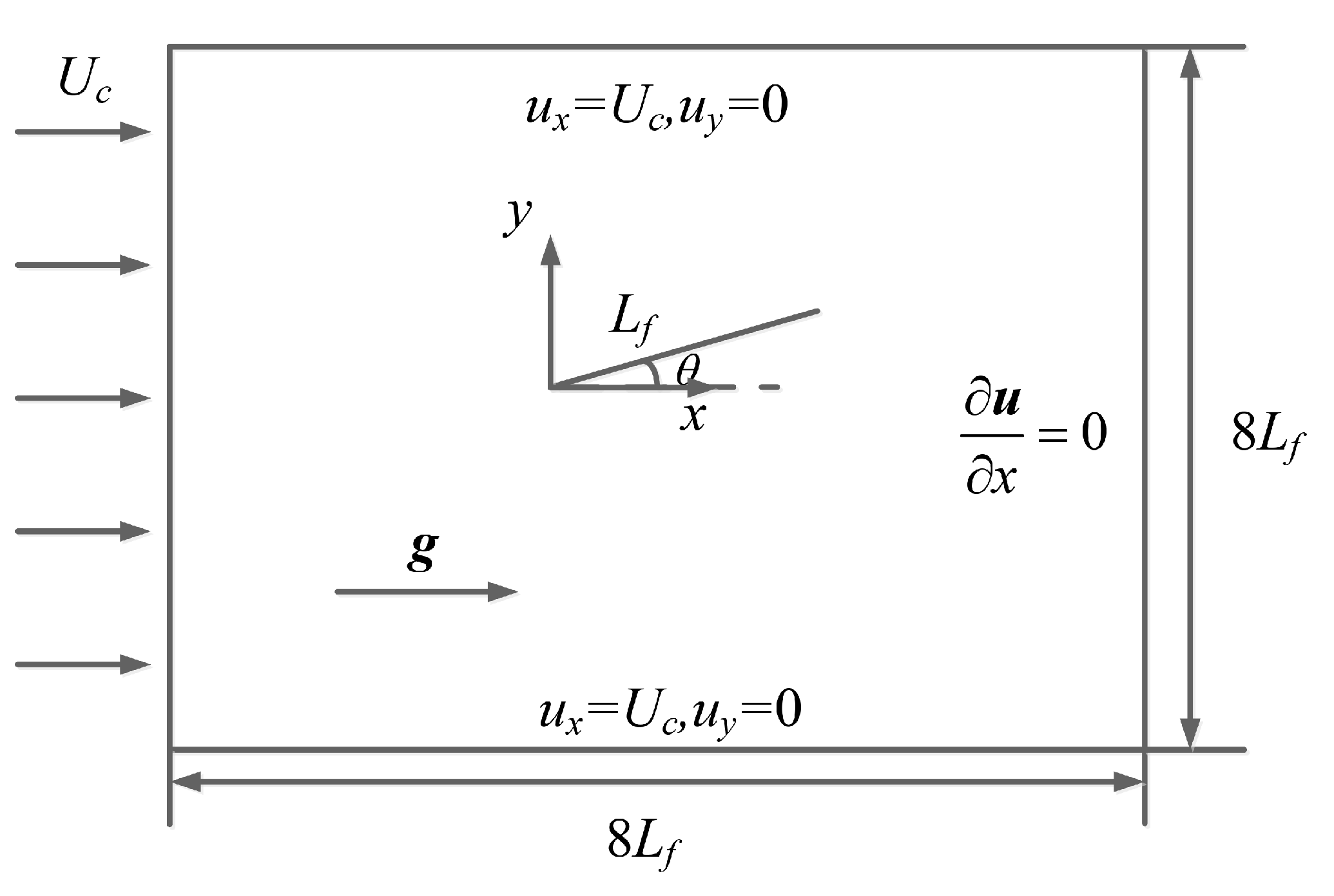
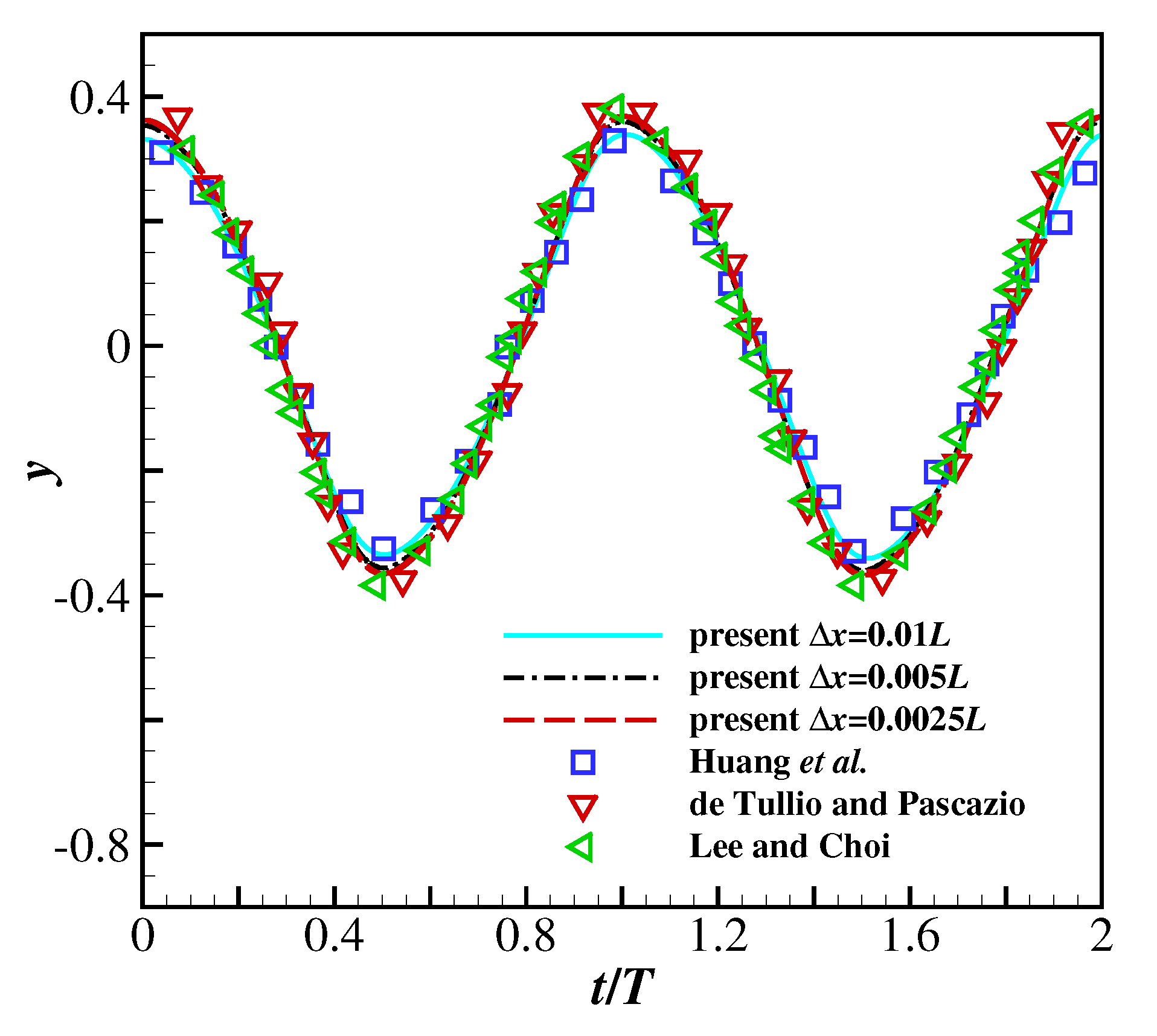
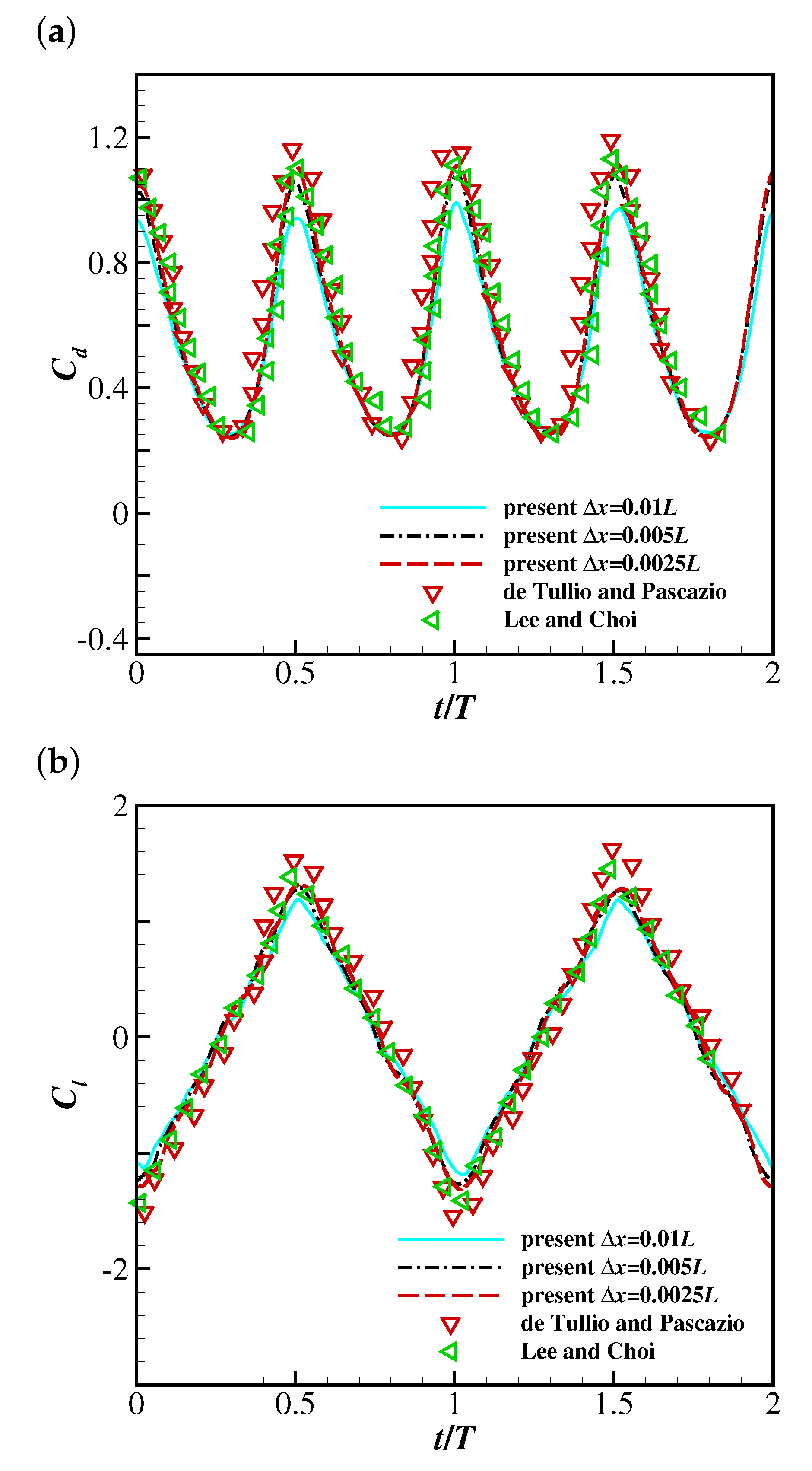

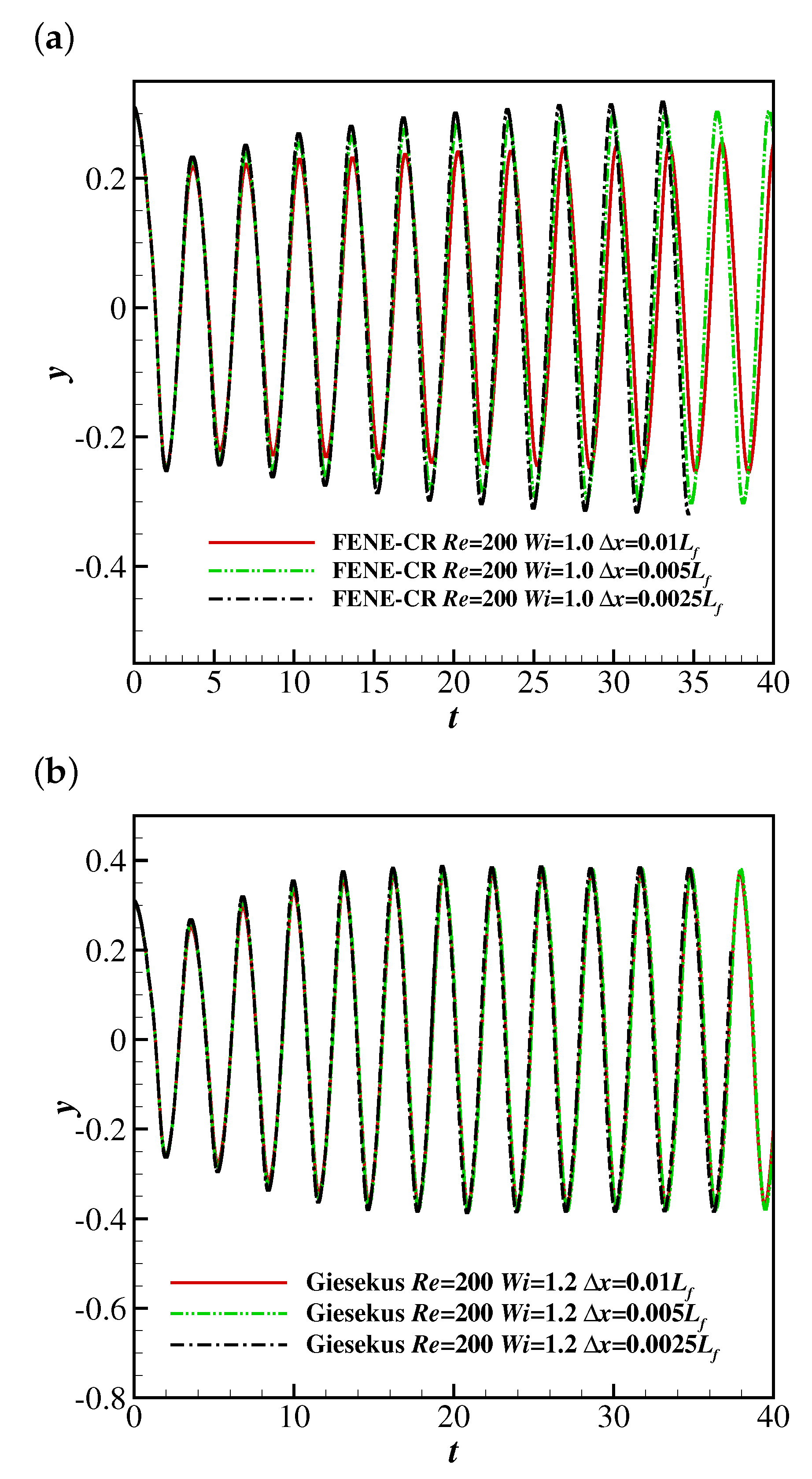


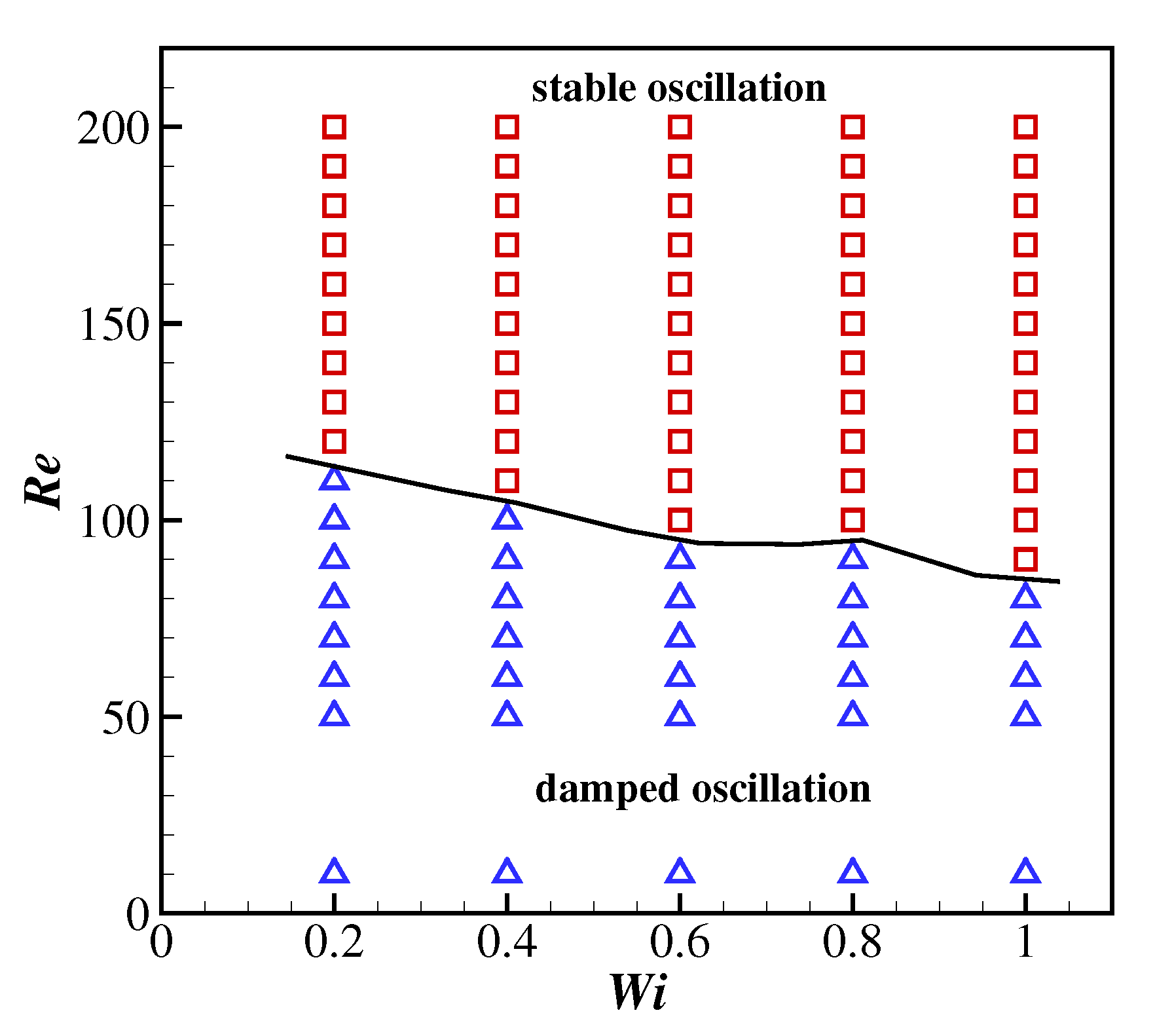
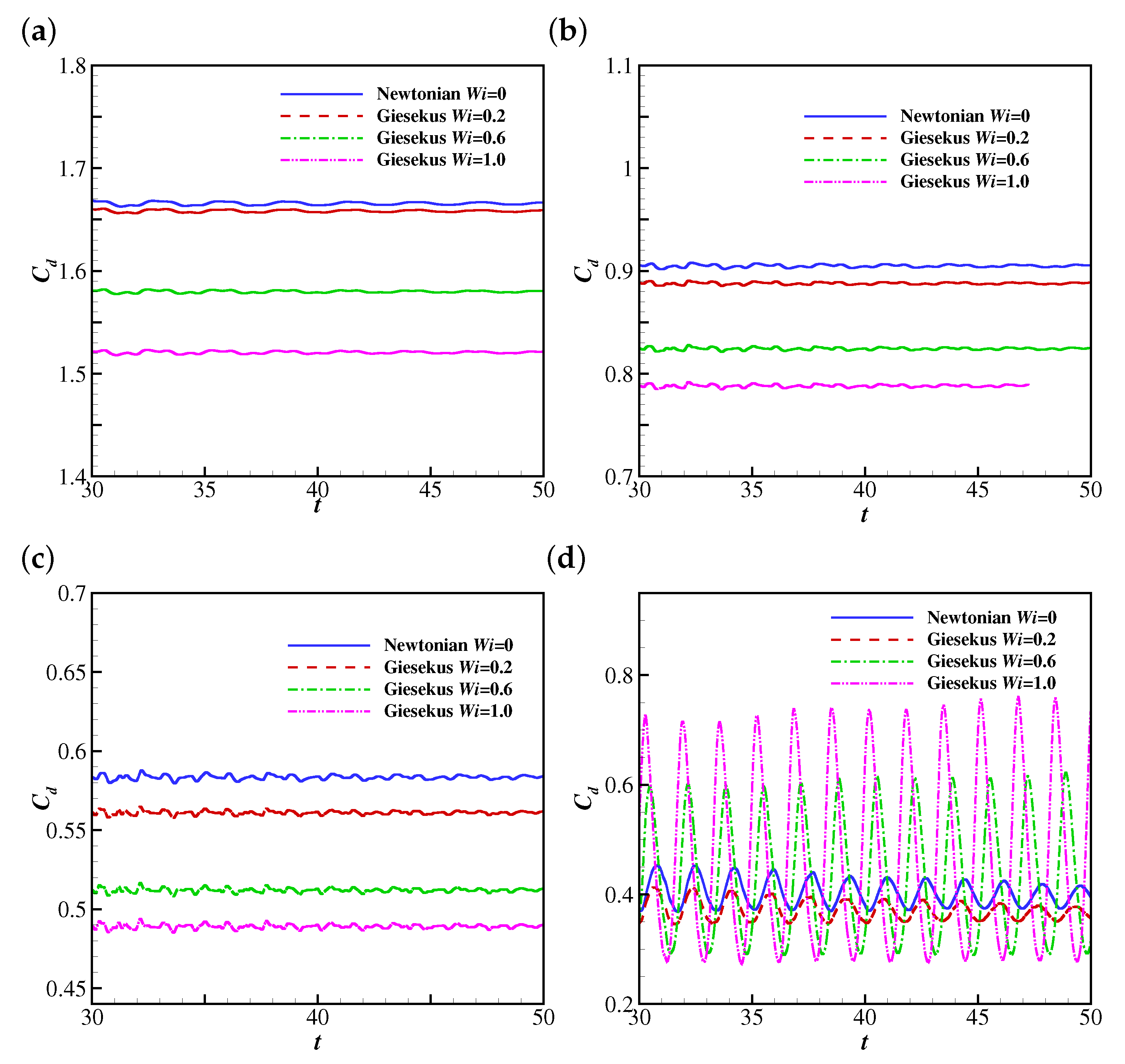
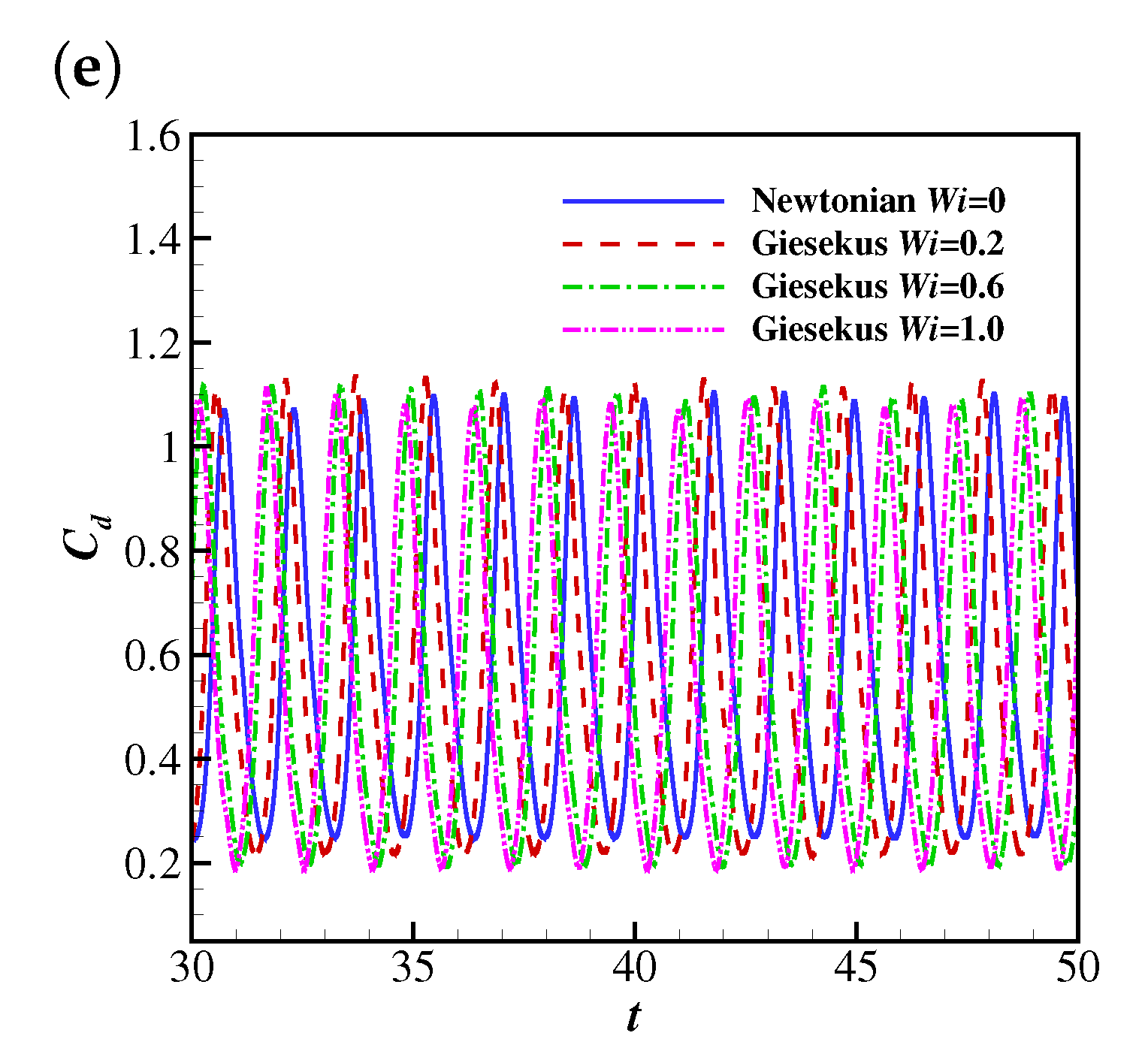

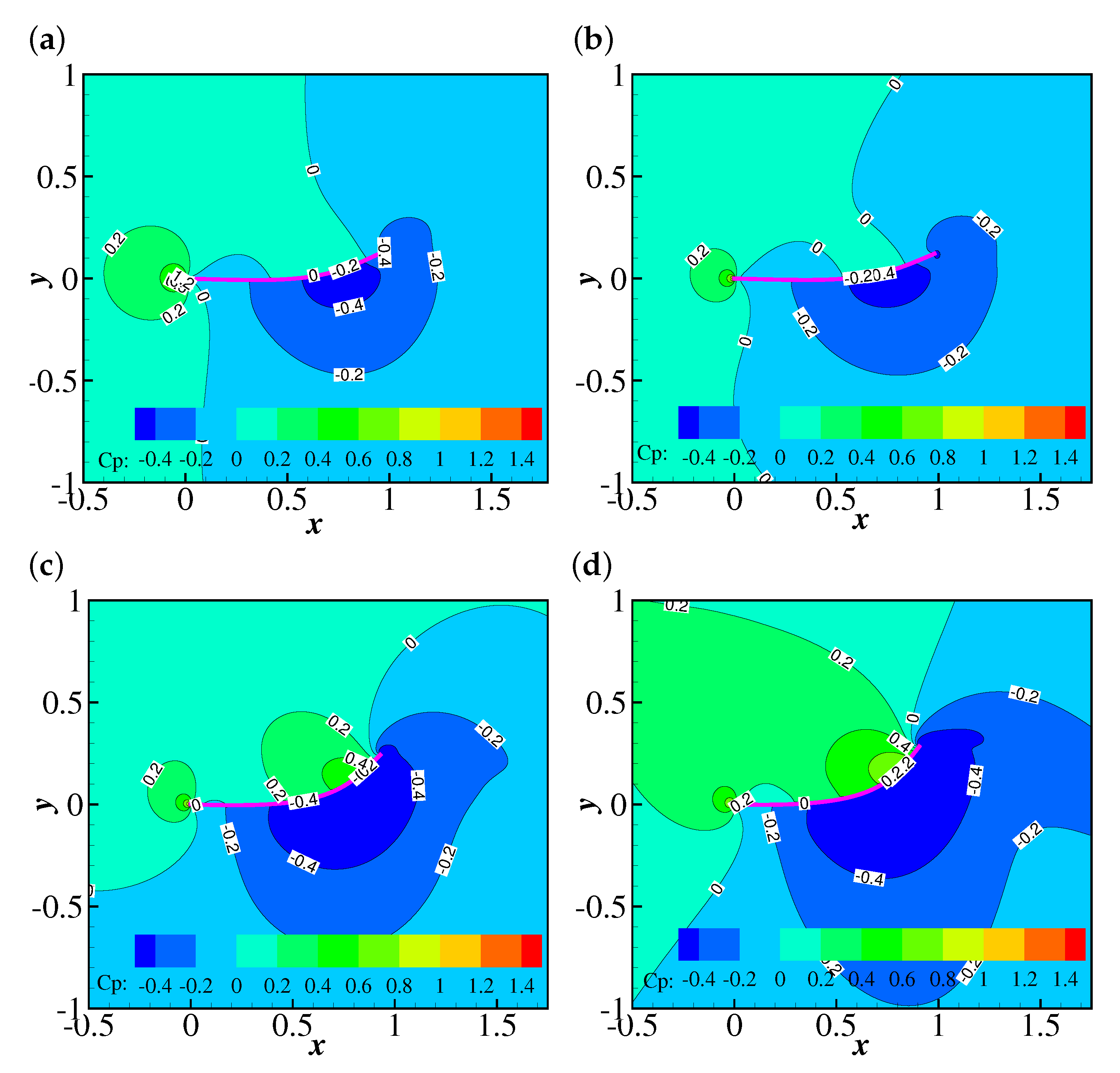
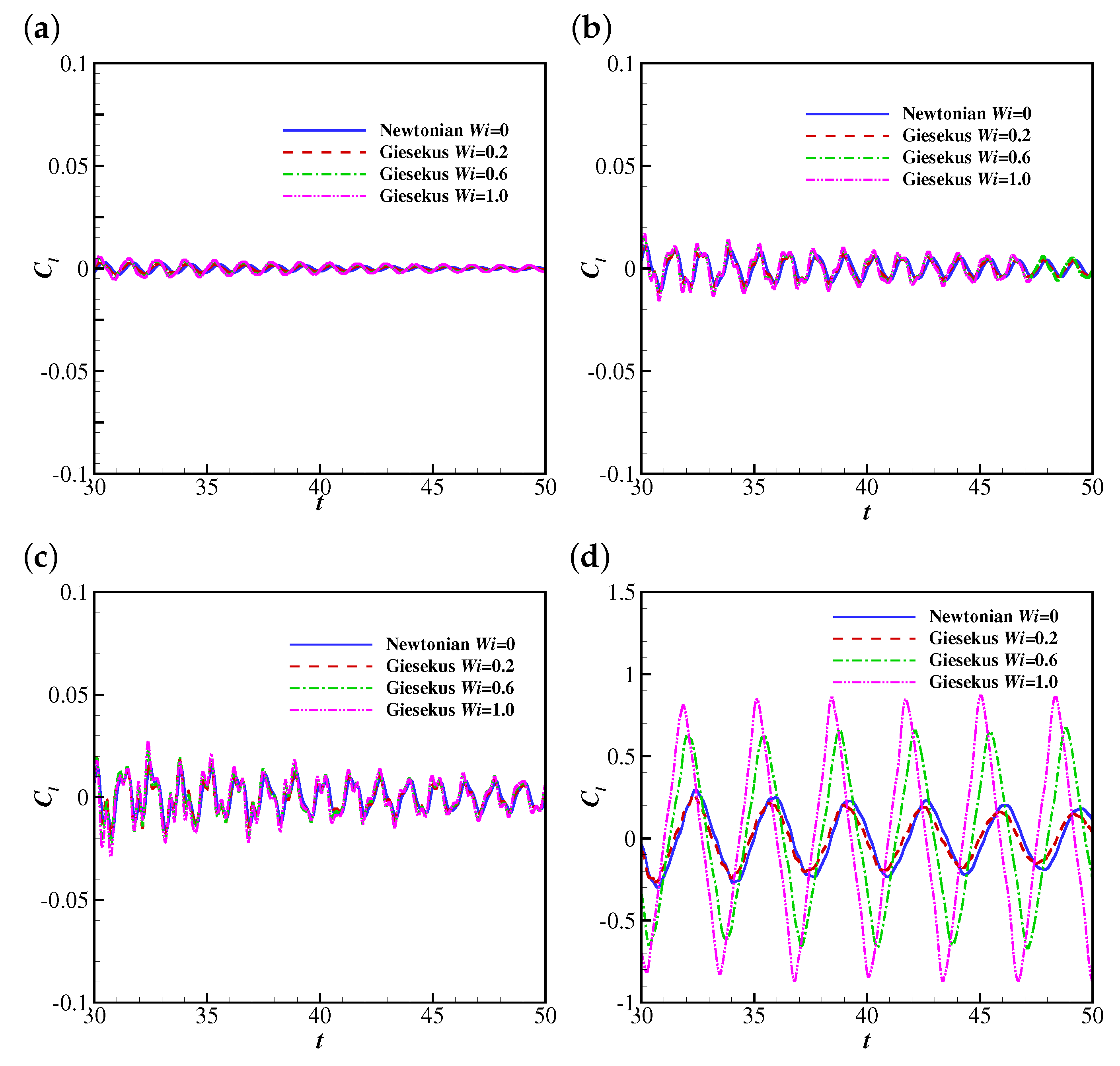
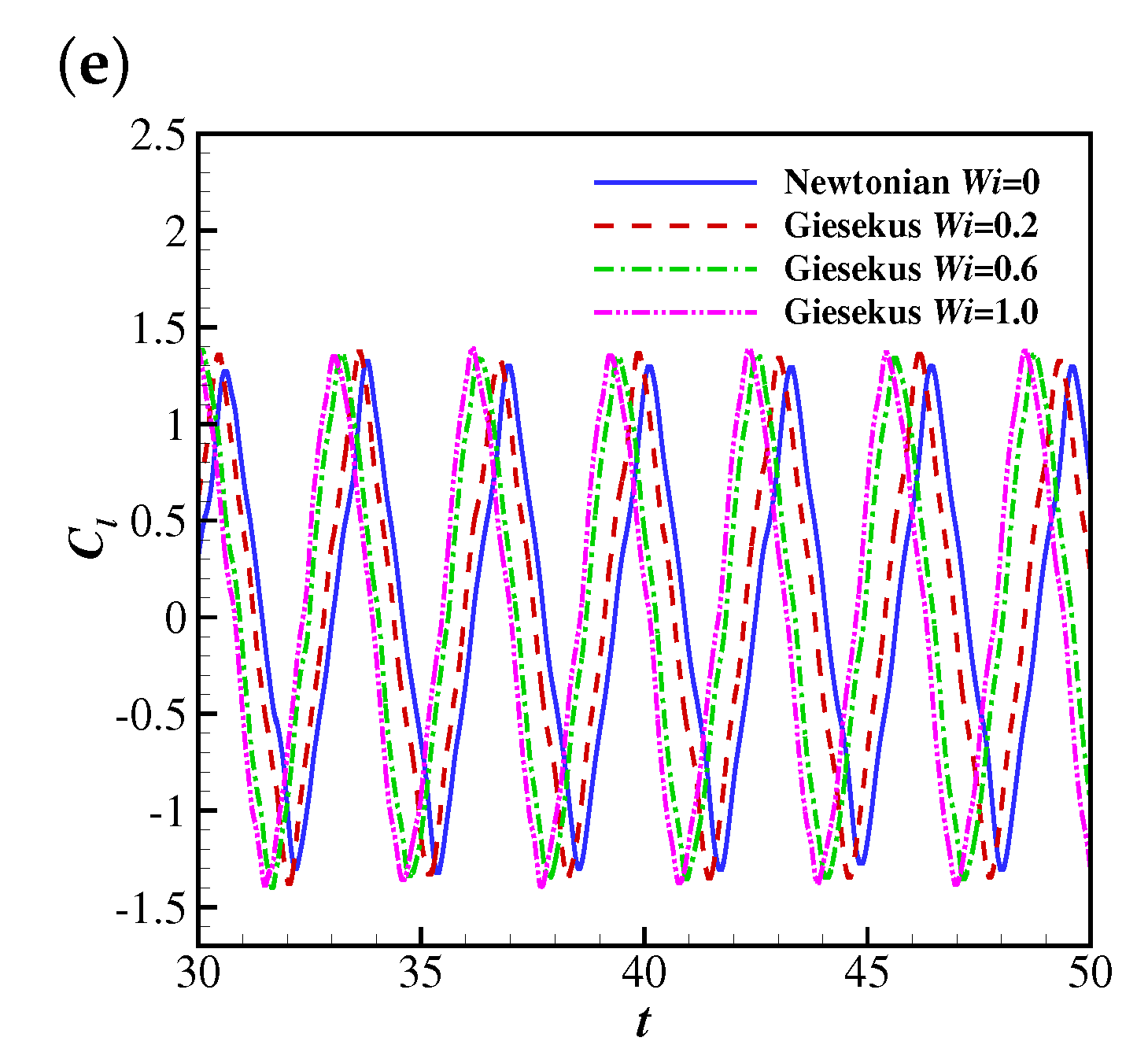


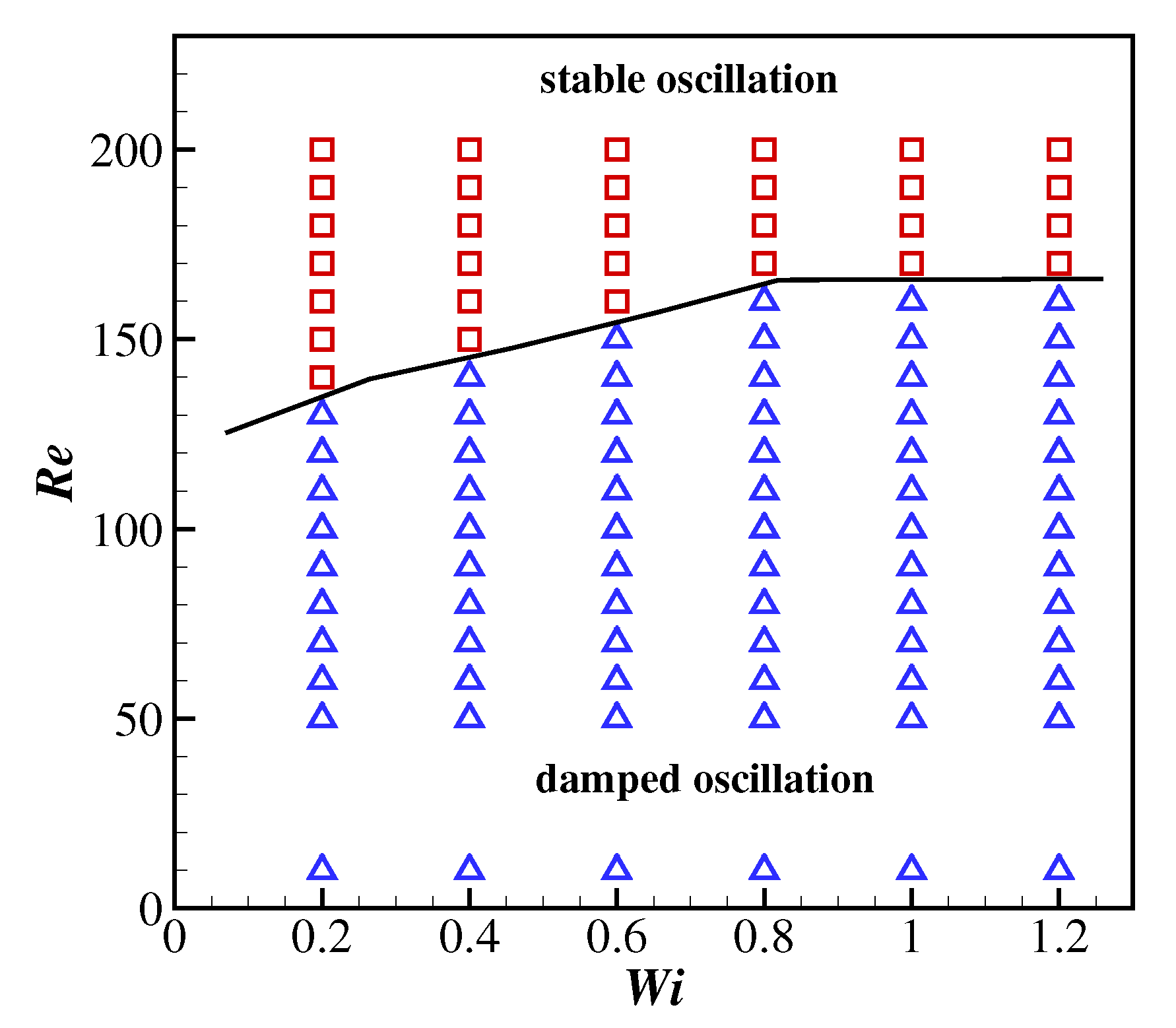
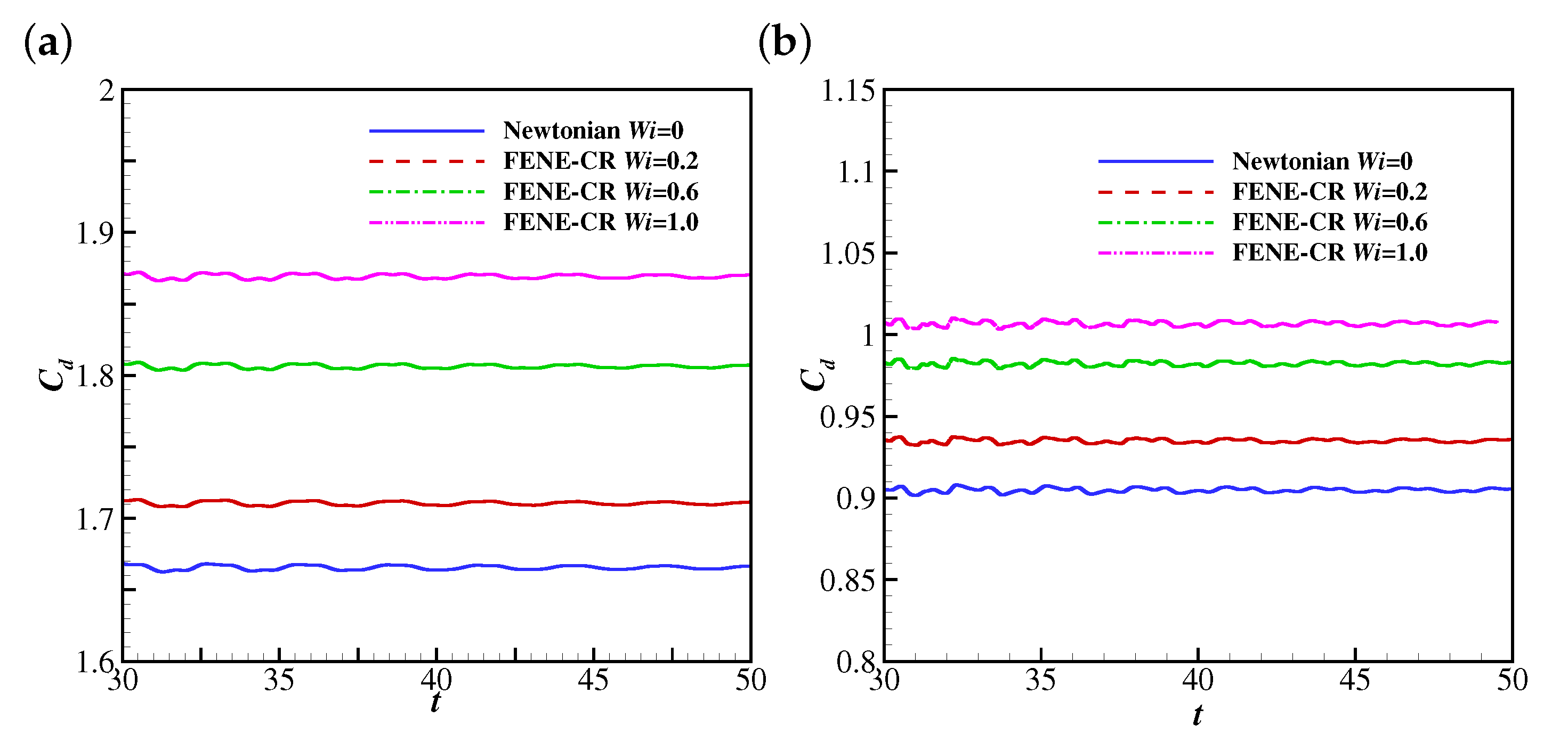

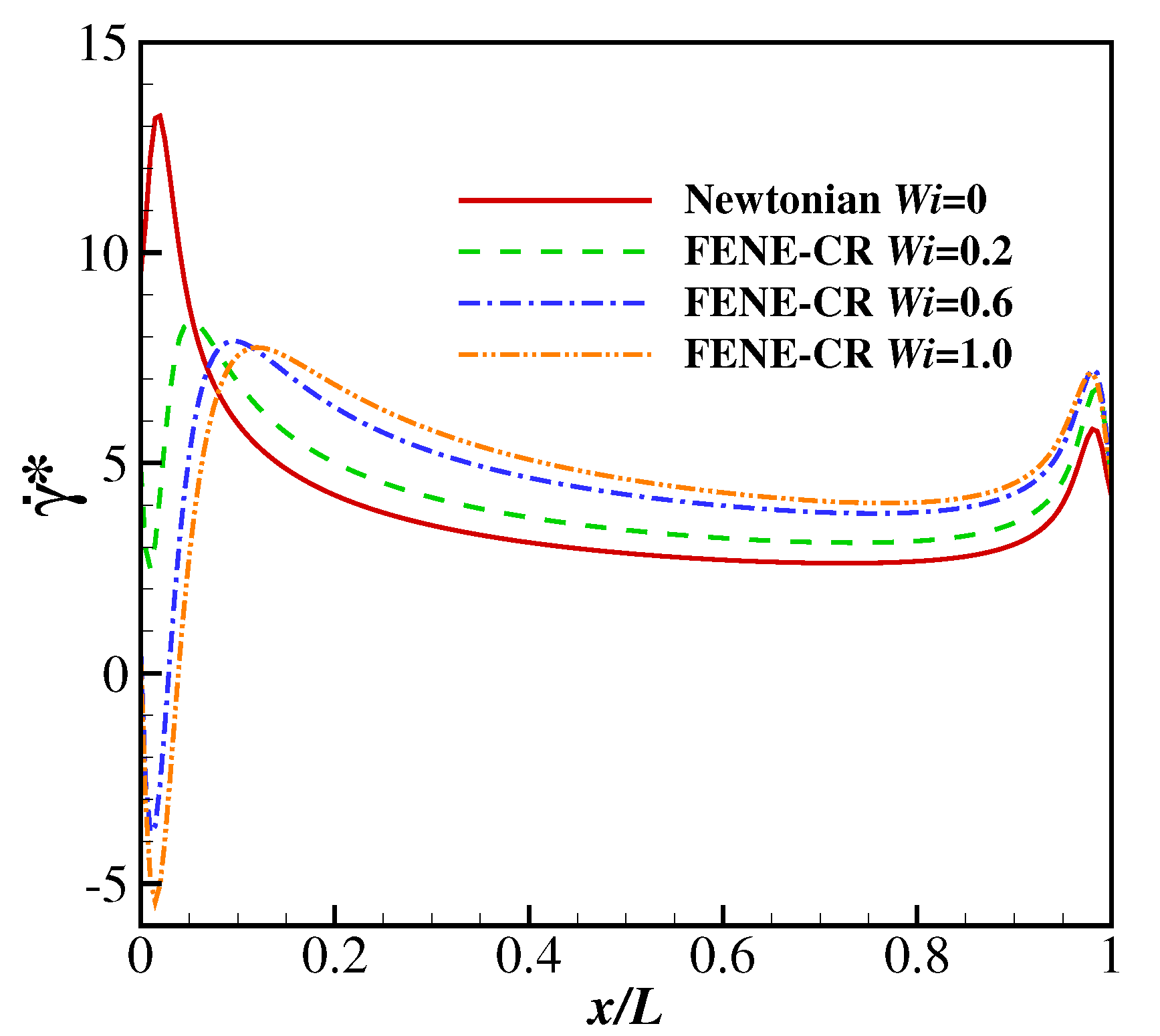
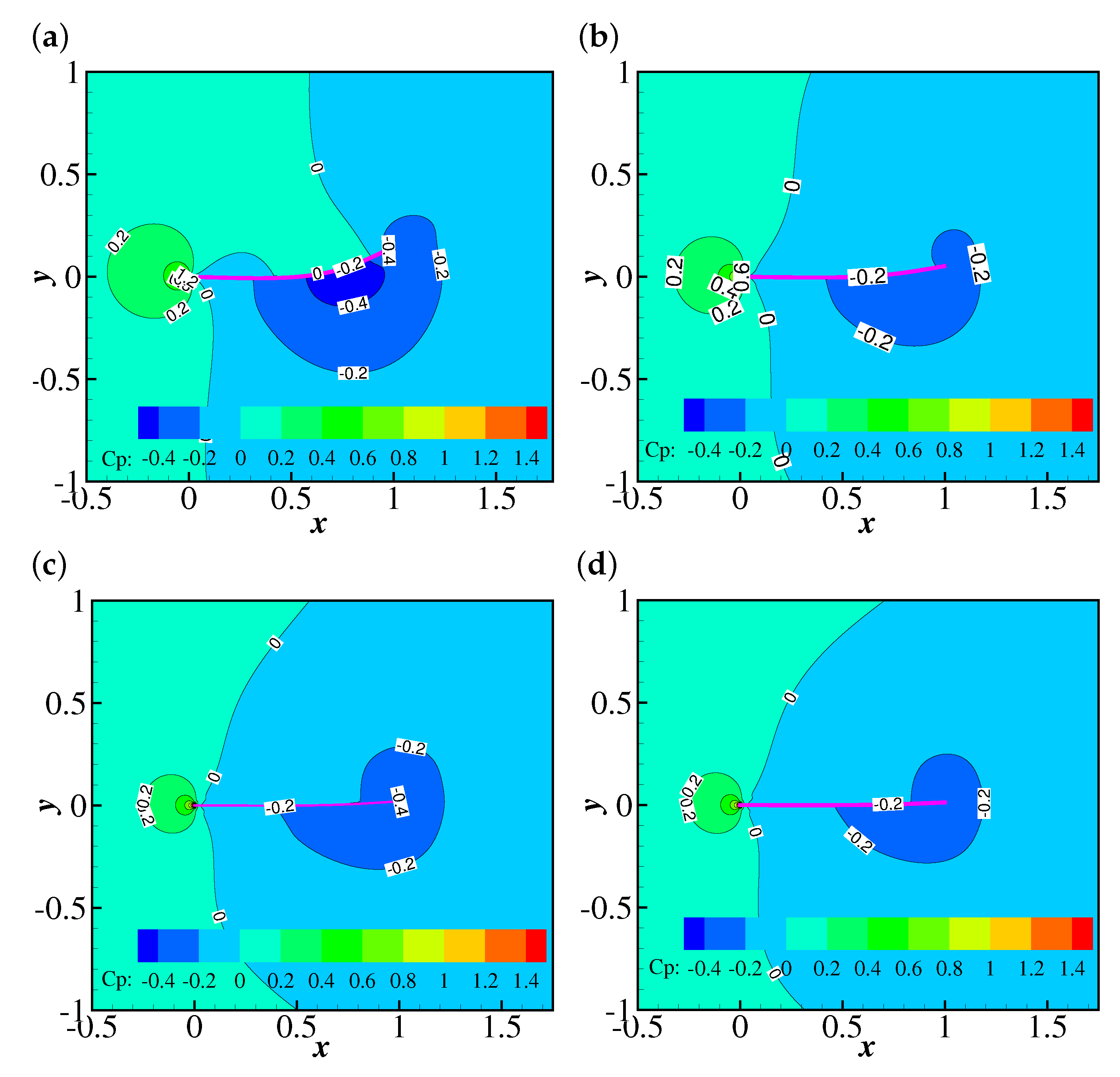

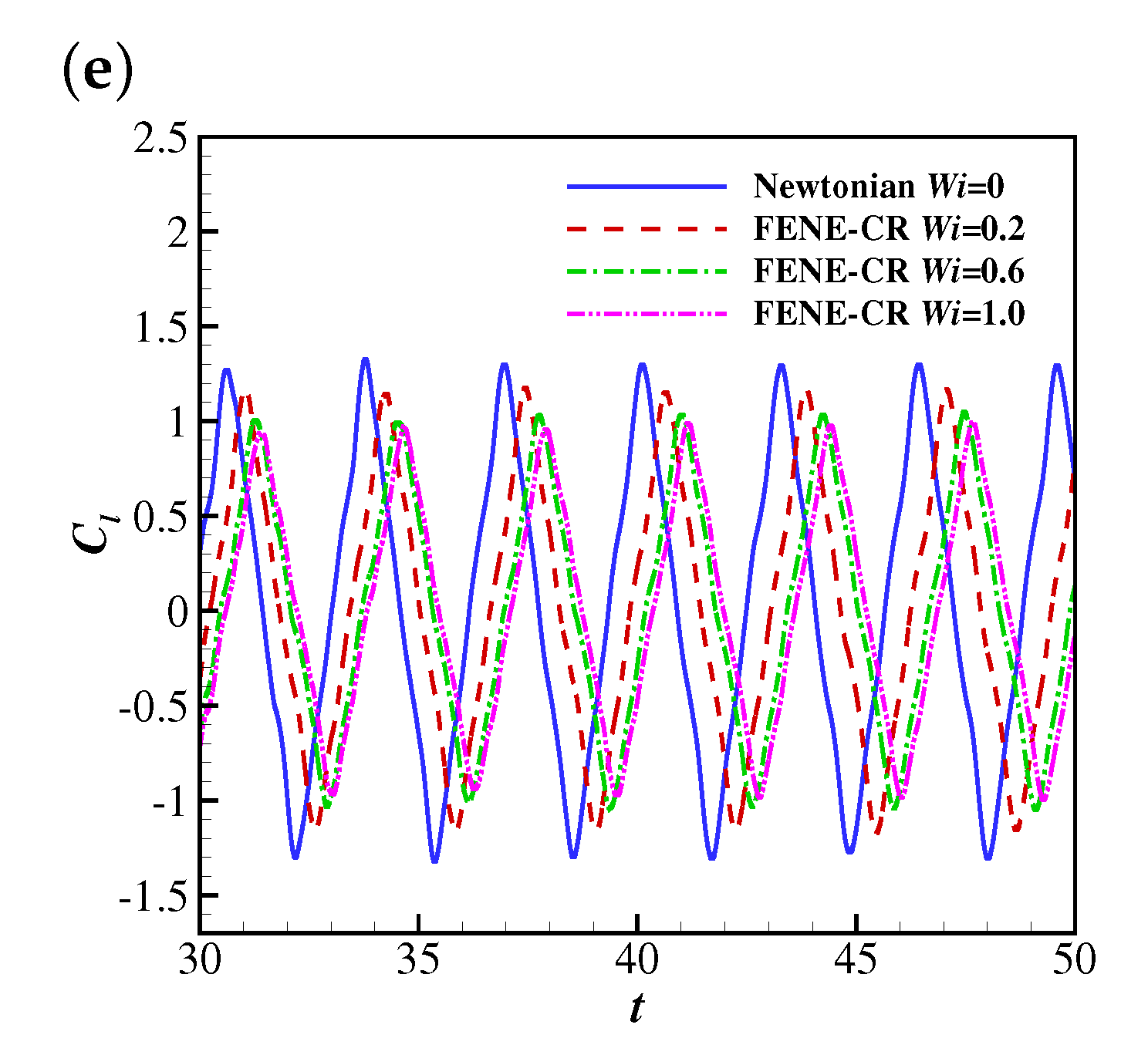
Publisher’s Note: MDPI stays neutral with regard to jurisdictional claims in published maps and institutional affiliations. |
© 2021 by the authors. Licensee MDPI, Basel, Switzerland. This article is an open access article distributed under the terms and conditions of the Creative Commons Attribution (CC BY) license (http://creativecommons.org/licenses/by/4.0/).
Share and Cite
Ma, J.; Tian, F.-B.; Young, J.; Lai, J.C.S. Dynamic Behaviours of a Filament in a Viscoelastic Uniform Flow. Fluids 2021, 6, 90. https://doi.org/10.3390/fluids6020090
Ma J, Tian F-B, Young J, Lai JCS. Dynamic Behaviours of a Filament in a Viscoelastic Uniform Flow. Fluids. 2021; 6(2):90. https://doi.org/10.3390/fluids6020090
Chicago/Turabian StyleMa, Jingtao, Fang-Bao Tian, John Young, and Joseph C. S. Lai. 2021. "Dynamic Behaviours of a Filament in a Viscoelastic Uniform Flow" Fluids 6, no. 2: 90. https://doi.org/10.3390/fluids6020090
APA StyleMa, J., Tian, F. -B., Young, J., & Lai, J. C. S. (2021). Dynamic Behaviours of a Filament in a Viscoelastic Uniform Flow. Fluids, 6(2), 90. https://doi.org/10.3390/fluids6020090






